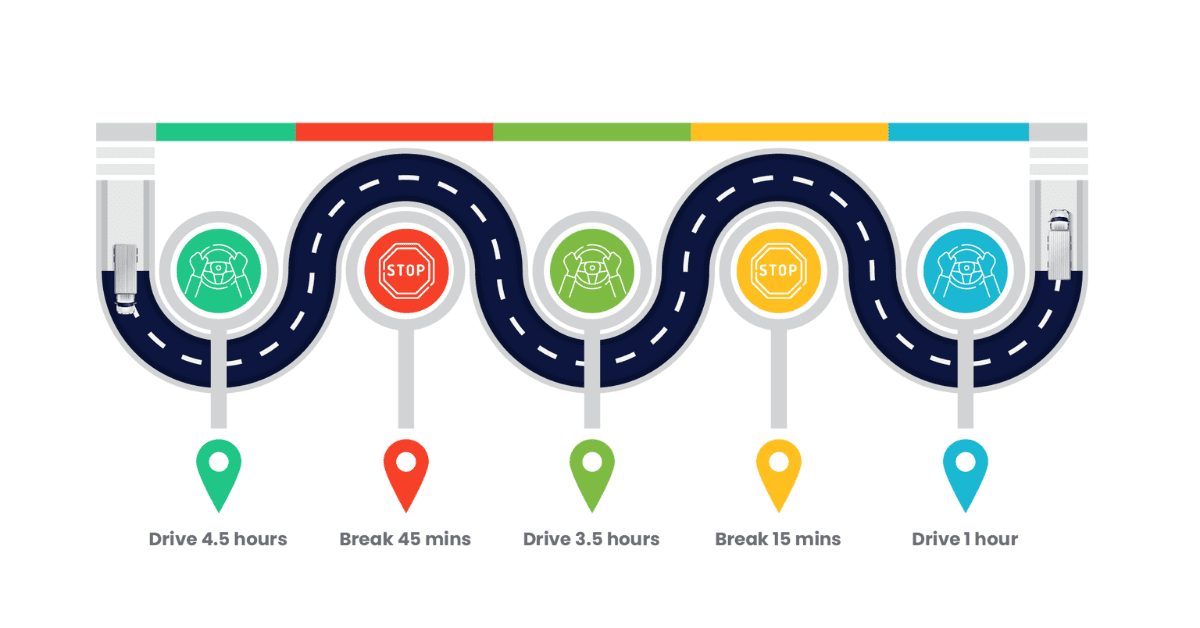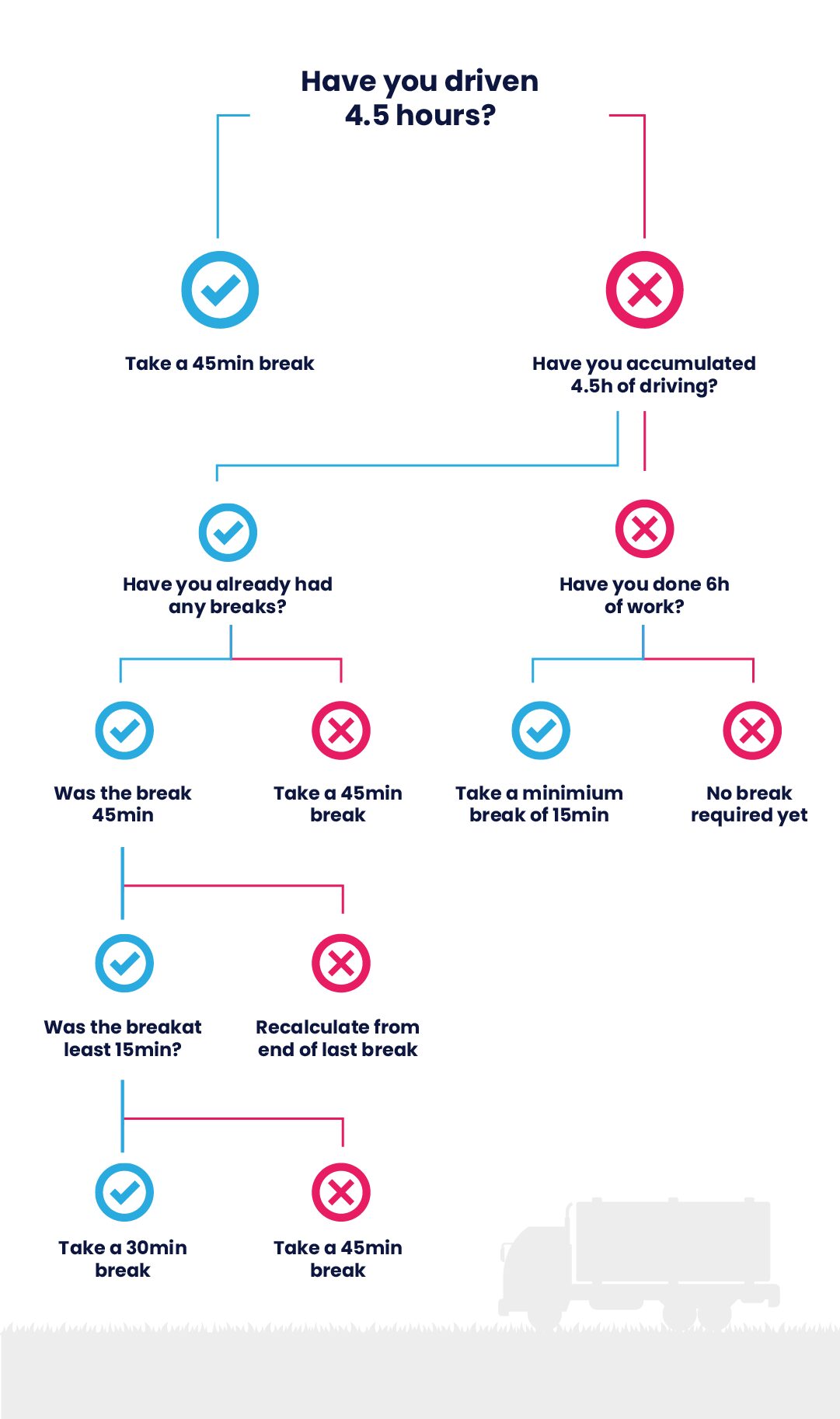HGV Drivers' Hours Simplified
For haulage operators and lorry drivers, getting to grips with understanding all the regulations of both drivers’ hours and required breaks can often seem complex and daunting. Getting this right is not only important to avoid penalties, but also to ensure the safety of drivers and others on the road. In this comprehensive guide, we aim to simplify the existing rules on HGV driving hours.
Laws and regulations can often change, so to stay compliant we’d always advise to check the government website to ensure the accuracy of driving hours and to see if these have been updated in recent.
Who do driving hours apply to?
These rules apply to drivers of goods vehicles or combinations exceeding 3.5 tonnes unless specific EU-wide exemptions. Further details on any exemptions can be found on the government website.
How many hours can HGV drivers work in a day?
HGV driving hours in the UK directly reflect the EU driving hour laws, with very close transport and supply chain channels, this makes it easier for drivers to know whether they’re complying with legislation in the country they’re driving in.
The daily driving limit is set at 9 hours, extendable to 10 hours twice a week.
How many 15-hour days can a driver work?
The laws around how many hours someone can operate a heavy goods vehicle in a 24-hour period states an HGV driver must rest for a minimum of nine hours within a 24-hour period up to three times a week. Consequently, this gives drivers flexibility to work three 15-hour days within the same week.
How many hours can HGV drivers work in a week?
HGV driver’s hours are limited to 56 hours per week, and the fortnightly limit is 90 hours. However, the rules do become more complex than restricted hours per week. Drivers are obliged to take regular, uninterrupted breaks to rest and be ready to drive with full concentration for the safety of themselves and other drivers on the road.
When should HGV drivers take breaks?
After 4.5 hours of driving, a 45-minute break is mandatory for all drivers. This break can be split into two periods: a minimum of 15 minutes followed by at least 30 minutes, all completed after 4.5 hours of driving. Breaks of less than 15 minutes would not qualify as breaks, however they wouldn’t be classed as driving time either. The EU driver’s rules and regulations state that only split breaks that show the secondary period being 30 minutes or over will be allowed.
Here’s a high-level overview of what this could look like:

The strict rules regarding driver’s break patterns are to ensure maximum concentration when a driver is behind the wheel. It is essential that any breaks taken mustn’t be uninterrupted.
We’ve created a quick checklist you can go through to see if you’re in need of a break:

How to record driver’s hours
Stringent recording of driving time is imperative to remaining compliant with UK and EU legislation. Driving hours should ideally be recorded on tachographs, whether it be digital or analogue. Employers are responsible and must maintain records of working time, for on-the-spot roadside inspections by traffic officers or if the DVLA request to see driving hours documentation. Failure to do so could result in serious consequences including hefty fines for both driver and business.
Possible penalties may include:
- A prohibition notice – for serious or dangerous offences.
- A fine or points on your licence (‘fixed penalty’) – the amount depends on how serious the offence is.
- Your vehicle being immobilised if it’s a danger to road safety – you’ll have to fix the problem and pay a release charge.
Other penalties include things like:
- An offence rectification notice – for offences that are not risk to road safety.
- A verbal warning – for minor offences.
How technology can help manage driver’s hours
As we mentioned previously, driver’s hours should be collected ideally by a tachograph whether that is digital or analogue. By implementing a digital tachograph, data can be automatically extracted from the vehicle and fed directly into Transport Management Systems (TMS).
HGV driver’s hours app
Study shift behaviour, from simple hours worked to a full breakdown of activity with the Mandata Team Admin app, which lets you record any of the following:
- The start and end of drivers’ shifts.
- How long each load or job has taken, using the stopwatch feature to accurately time each activity.
- A full breakdown of every activity.
- Nightshifts.
By integrating tachograph and shift behaviour data into TMS, office staff will have a live view of driver’s working hours and availability, meaning when planning for upcoming jobs office staff can avoid overcommitting drivers to certain routes – from here the planners will be able to see if the jobs is better suited to another driver or split. Office staff will also have a real-time view of drivers approaching their hourly limits and be able to delegate accordingly.
HGV Driver’s Hours Calculator
If you don’t use a tachograph to keep track of your driver’s hours, another option could be creating a work shift pattern using a driver’s hours calculator. It effortlessly computes your rest periods, starting times, and maintains a precise record of both driving and working hours. My Driving Hours and HGV City are great places to start.
We hope this comprehensive guide to HGV drivers’ hours and regulations has been helpful. For a more detailed examination, please refer to the provided links. Additionally, consider using HGV drivers’ hours apps or online calculators to stay compliant with rules and accurately track your driving and working hours.

